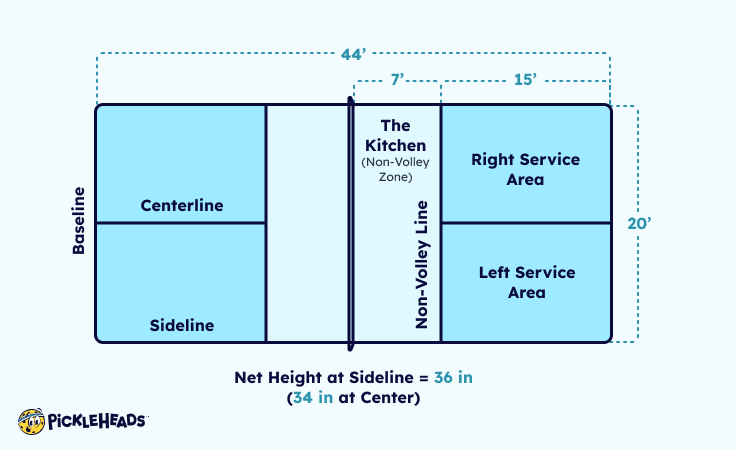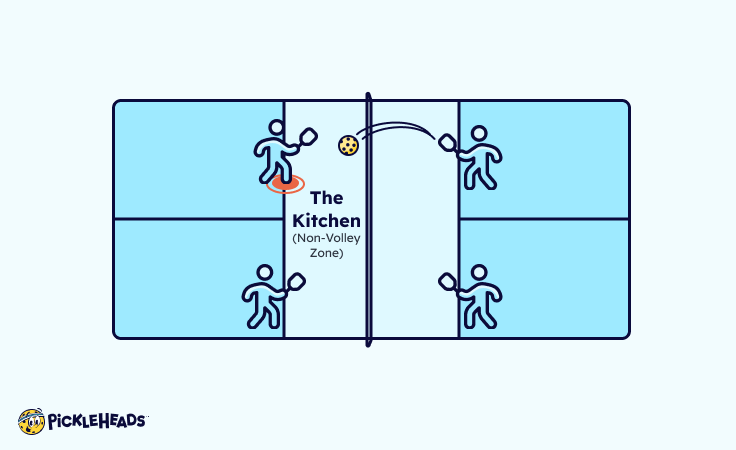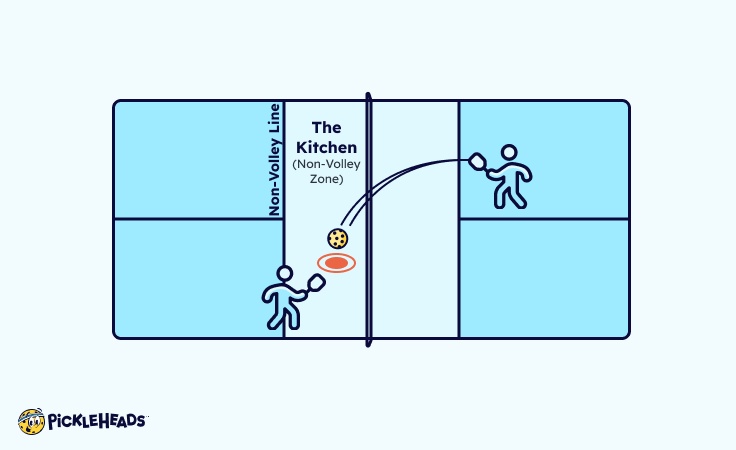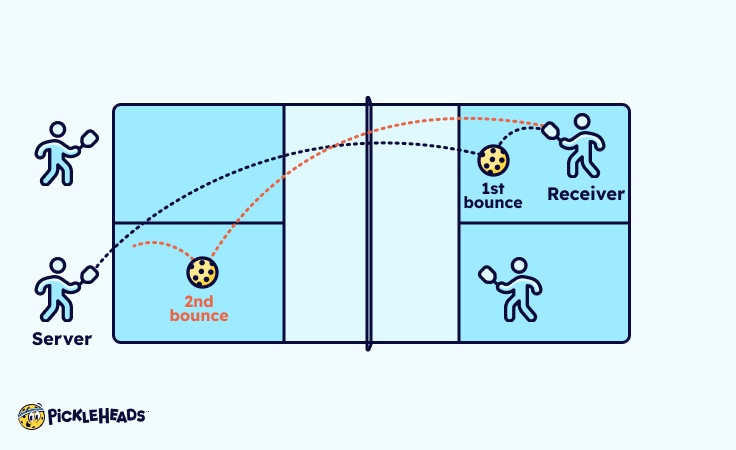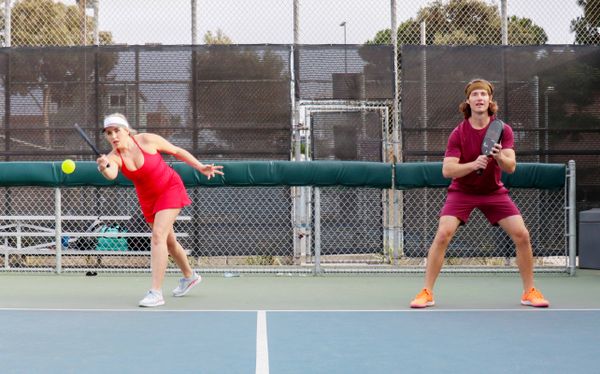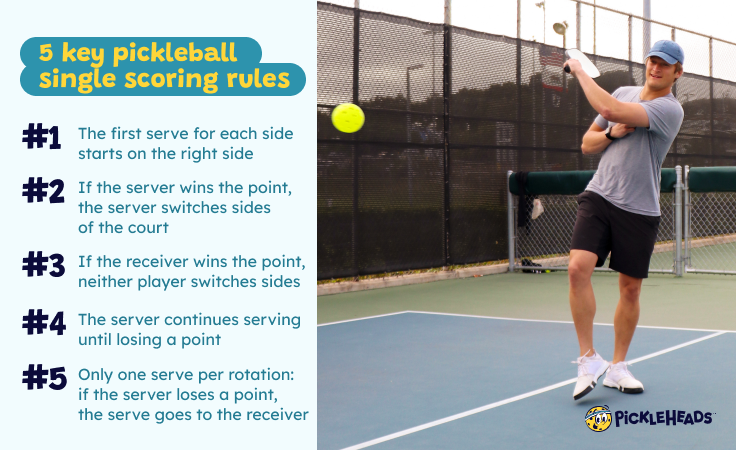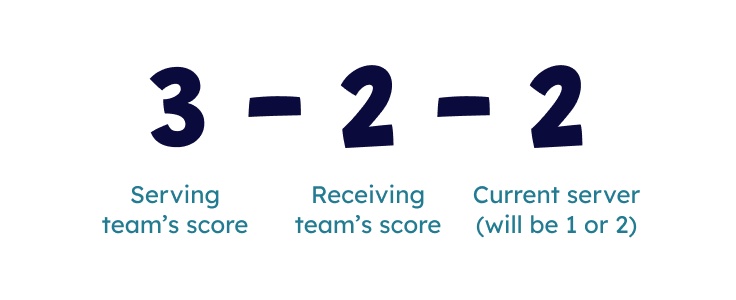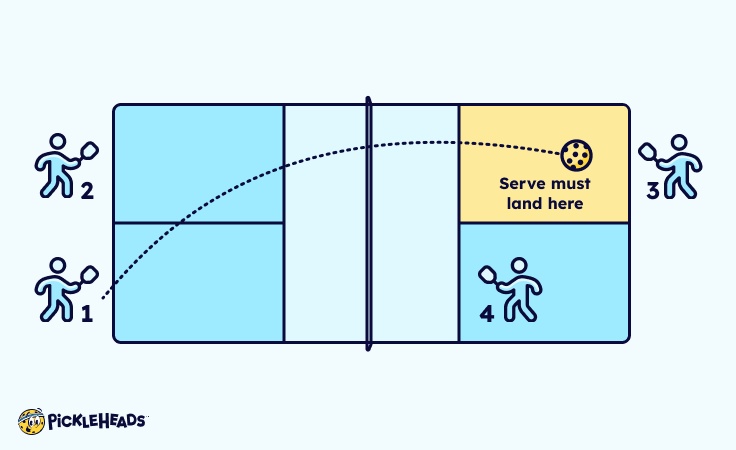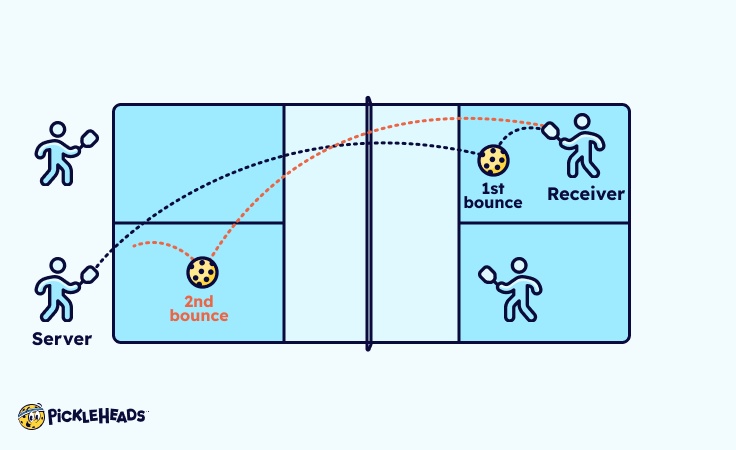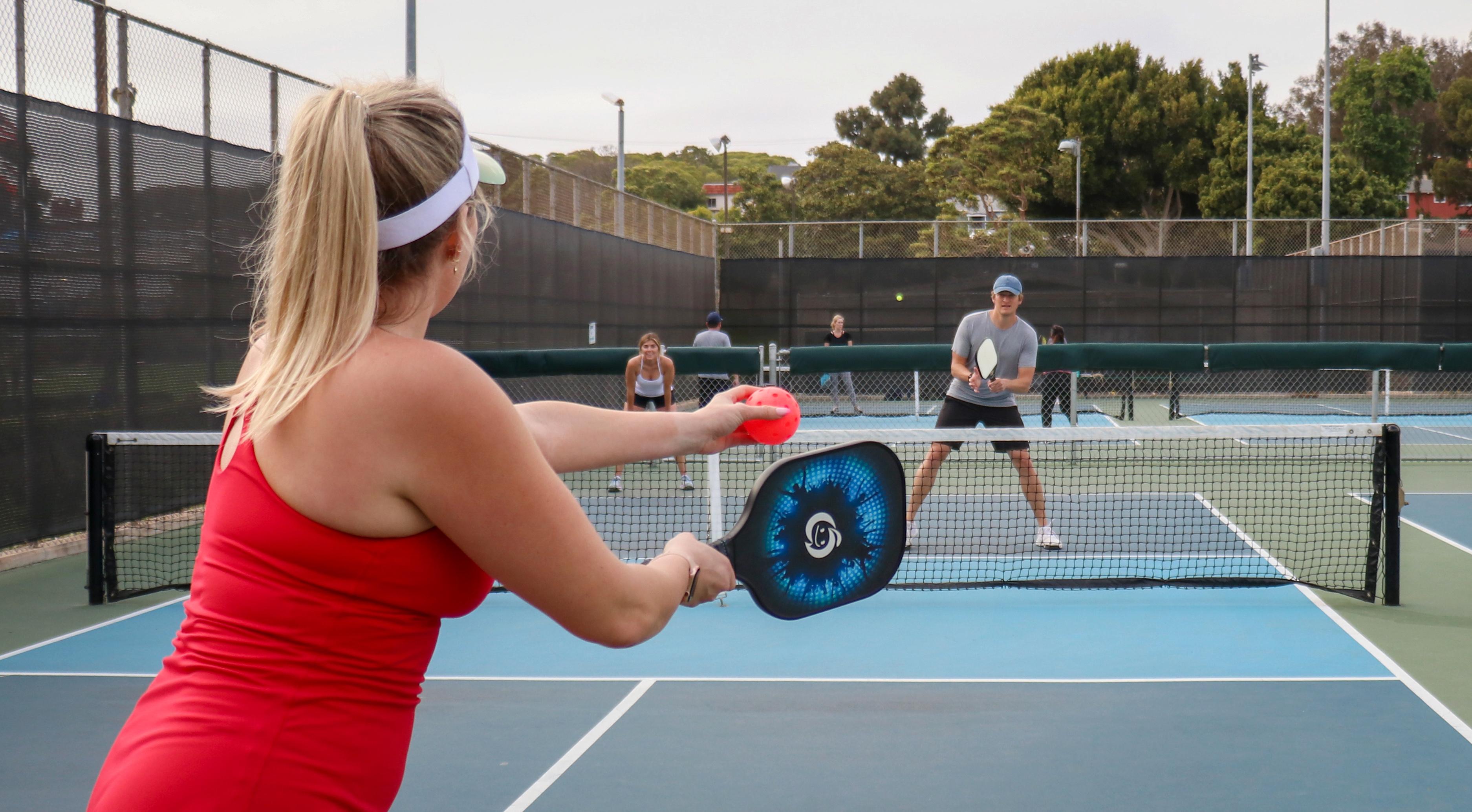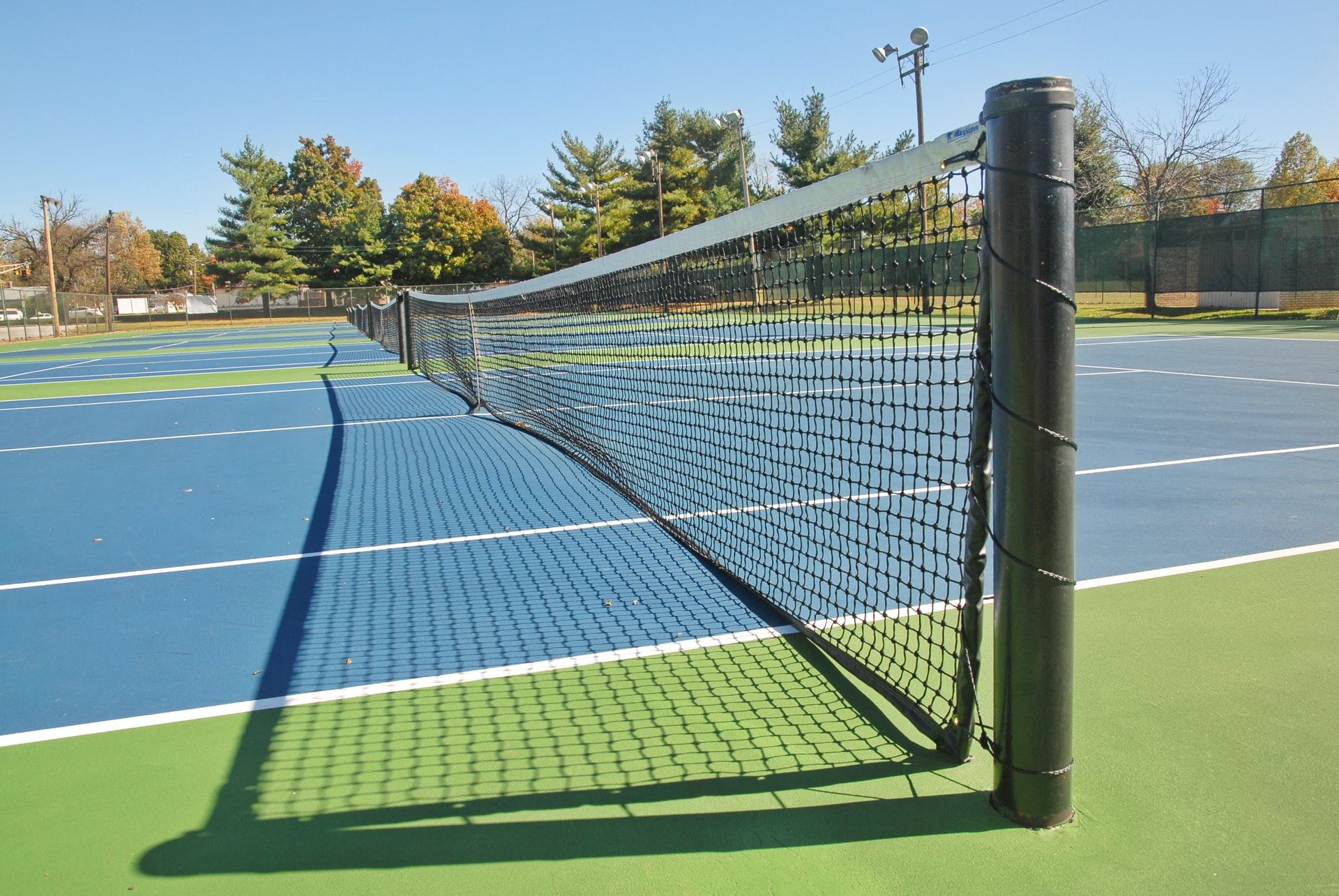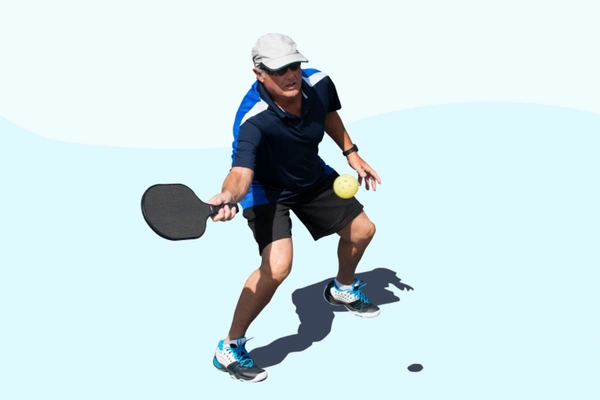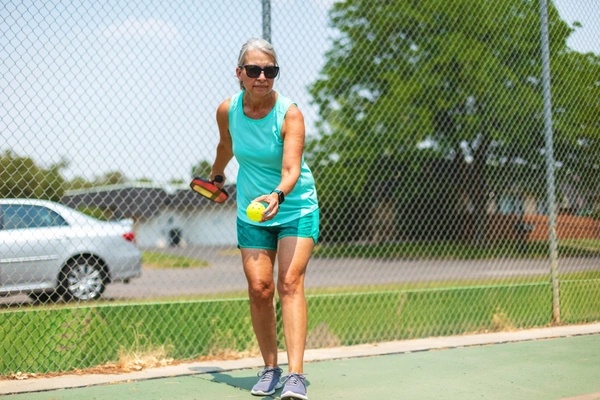
Quick Links
Ready to play Pickleball?!
You’re not alone… it’s the fastest growing sport in America. And it’s tons of fun!
But maybe you’ve never played before. Or need a refresher on how to play.
Just follow these 9 simple rules and you’ll be out playing in no time.
How to Play Pickleball: The Court Set Up
Pickleball is played on a badminton-sized court (20' x 44'):
The net is 36 inches high at the sideline, and 34 inches at the center. Pickleball is most often played as doubles with 4 players, two on each team (though singles is possible as well). Each player stands to the right and left of the centerline.
You can hit two types of shots:
- Groundstrokes - hit off the bounce, often from the baseline
- Volleys - hit out of the air from a position closer to the net
Each side has a 7 ft area called the Non-Volley Zone, or “Kitchen”, where no player can hit volleys from. Not even a toe can touch the kitchen line during a volley (more on that later).
Now that we have the court set up, let’s get playing!
Rule #1: Each Point Begins with a Serve
The pickleball game – and each point – starts with the serve. The player on the right side of the court, facing their opponents, starts the serve. You serve diagonally to your opponent, into the right or left service area:
The serve must clear the "Kitchen" (including the line) to count.
Rule #2: Your Serve Must Be Underhand
A pickleball serve must be hit with an underhand stroke with contact below the waist. Your arm must move in an upward arc when you strike the ball.
You can hit the ball out of the air (as most players do). Or you can drop the ball on the ground and hit.
The goal of the pickleball serve is to put the ball in play. This is quite different than a tennis serve, where the goal is to serve overhand aggressively to win the point.
Here’s a quick primer from Wayne Dollard of Level Up Pickleball Camps on how to serve:
Rule #3: Each point continues until a fault
After the serve, gameplay continues until a “fault” is committed. A fault ends a point.
In pickleball, there are basically 3 types of faults:
- The serve does not clear the kitchen (including the line)
- A shot is hit out of bounds - landing behind the baseline or outside the sideline
- A shot is hit into the net
Note there is no “let” in pickleball – meaning if a serve hits the net, there’s no redo. The ball is played as it lands.
We’ll also cover 2 more advanced faults later in our rules.
Rule #4: You cannot volley while standing in the kitchen
The 7 ft zone on each side marks the “non-volley zone,” or kitchen.
This means you can never hit a volley – which is a shot hit out of the air – while having any part of your body in the Kitchen. Or even on the Kitchen line. And you can’t let your momentum carry you into the kitchen after a volley either.
Why this rule? Once you play, you’ll see players at the net have a big advantage. They can hit any ball high enough with a downward “smash.” This shot puts opponents right on the defensive.
Pickleball’s inventors learned standing right on the net made volleying too easy. It was an unfair advantage and took the fun away (for the defenders that is!). And so the “Kitchen” was born.
Rule #5: You Can hit Groundstrokes in the Kitchen
If your opponent hits a short shot landing in the kitchen, what’s called a dink, you can enter and hit from the kitchen.
Dinks are a defensive shot, and one of the most important parts of pickleball strategy. Often your best move after moving into the kitchen to field a dink is to dink right back to your opponent’s kitchen.
Rule #6: The Ball Must Bounce on Both Sides Before Either Team Can Volley
Before any player can hit a shot out of the air (a volley), the ball must bounce at least once on each side. This means if your partner is serving, and you start up at the kitchen, you’re in a dangerous position…
Why? Because the returning team can hit a shot right at you, and if you react with a volley, that’s a fault. You lose the point.
This rule keeps the serving team back on the baseline to start. Without it, the serving team could easily rush the net and gain an unfair edge every time. The return team would struggle to ever regain the serve and get points, as we’ll cover in our next rule.
Rule #7: You only win points on your serve
In Pickleball, you only win points on your serve, and you continue serving until you lose a point. After winning each point on your serve, you switch sides with your partner and serve to the other opponent.
What happens if you lose the point on your serve? We’ll cover that below in Rule #8:
Rule #8: Both partners serve in a turn
In each turn, both players (in doubles) get the opportunity to serve. And in pickleball scoring, you’ll hear players announce three numbers, “Zero, zero… two.”
What the heck is that third number? It tracks which of the two players on a team has the serve.
Let’s say the game is tied at 3-3. If you start the serve (from the right side remember), you’ll announce “3-3-1,” so everyone knows you are the first player in rotation serving.
If you lose the point, the ball doesn’t go to your opponents. It goes to your teammate who will announce “3-3-2.”
Then if you’re partner loses their serve, the ball goes back to your opponents who will announce, again, “3-3-1.” And your team will now have win points on both opponent’s serves to get the ball back.
Ah and one exception to this rule… The first player to serve in the game calls out “0-0-2.” This is so the starting team only gets one serve. If both players served to start, the serving team would gain an unfair advantage over the returning team.
Confused yet? We promise it’s easy once you start playing!
Rule #9: First team to 11 points wins – and you must win by 2
Following all the rules above, the game continues until one team gets 11 points. The catch? You have to win by 2.
So if a game’s tied 10-10, the next score doesn’t win. The game continues past 11-10. This rule can have games on for a long time. You can have ending scores of 12-10, 15-13, or even 21-19. But these are often the most fun games!
How to Start a Pickleball Game
The pickleball game always begins with a serve.
Who serves first?
According to the USA Pickleball Association Rulebook, “any fair method shall be used to determine which player or team has the first choice of serve.” You can flip a coin. We’ve seen some local courts dictate the north side always serves first. So you can ask a local or come up with your own way.
Once the serving side is determined, the player on the right side of the court goes first.
They announce the starting score, which is always “0-0-2.” Each team starts with 0 points. The “two” indicates the starting team serves at position 2. Meaning they only get one serve on the first rotation (this is to prevent an unfair advantage). The server then serves underhanded to the diagonal side. If the serve is “in,” gameplay continues.
See more: How Pickleball Scoring Works.
So to recap that’s:
- Determine the first serving side by local rules or coin toss
- Player on the right side of the court serves first
- They announce “0-0-2” as the starting score
- Player serves underhanded (out of the air or off the bounce) to the diagonal side
- If the serve is “good,” beyond the kitchen line but inside the baseline and sidelines, the first point continues
How to Play Pickleball Singles
Doubles is the most popular way to play pickleball. But can you play singles…? Yes!
Playing singles pickleball works just like doubles. Except you have just 1 player on each side.
The major difference is in the scoring - there’s no need to call out the third number. The server calls out only two numbers - the server’s score (first), then the opponent’s score (second).
Here’s a scoring overview for pickleball singles:
There’s no second server - so if you lose the point on your serve, it goes straight to your opponent.
How do you know which side of the court to serve from in pickleball singles? In singles, the serve is always taken from the right side of the court when the server has an even number (0, 2, 4, 6, 8, or 10 points). When the server has an odd number of points (1, 3, 5, 7, 9), the serve is taken from the left side.
It’s only the server’s score that determines which side to serve from - not the combined score of server and receiver. All other pickleball rules on serving, faults, line call, and the Non-Volley Zone, or Kitchen, are exactly the same in singles as in doubles.
Check out this article from The Pickler for more on how to play pickleball singles and find winning singles strategies.
How to Play Pickleball Doubles
Doubles is by far the most popular way to play pickleball. In doubles, two players are on each team and share a side together. Each player has the chance to serve. The scoring is called out as:
The serve number indicates which server on the team has the serve. Let’s say you have 3 points, your opponent has 2, and you’re starting the serve.
You call out “3-2-1” and then serve.
If you lose the point, the serve will move to your partner, who will announce “3-2-2.”
Now all players know that if your team loses another point, you give up the serve to your opponents. This is called a “side out.”
Where to Stand During Pickleball Doubles
In pickleball, the ball must bounce once on each side before any player can volley (hit out of the air). This means if your partner is serving, you’ll stand back at the baseline. If you started at the kitchen, your opponent could hit a line drive return to you and if you volley, that’s a fault.
But how about returning? If your opponent is serving to you, you’ll want to stand behind the baseline to hit the return. But if the serve is going to your partner, your best position is right up at the kitchen - ready to volley. This is because the serve will bounce once on your side, your partner will hit the return, and then you’ll be clear to volley.
In pickleball, your best odds are playing up at the kitchen. Your partner should hit their return and immediately join you at the kitchen. Do this - and you’ll have the serving team on the defensive every time.
How Pickleball Scoring Works
Scoring can be confusing, especially for pickleball beginners. The pickleball score consists of 3 numbers:
The first number is your team’s score. The second number is your opponent's score. And the third number – the often confusing one – indicates who’s serve it is. It will always be a 1 or 2. In pickleball doubles, each player on a team gets the opportunity to serve. So you need to know which player is serving. And because you switch sides after each point you win, you can’t rely on your court position to remember who’s serve it is.
Let’s say you’re serving. Your team has 2 points, and your opponent has 1. If you're the first one serving, you’ll announce: “2-1-1”
If your team loses the point, the serve will go to your partner, who will announce “2-1-2.” Now all players know that if your team loses the next point, the serve will go to your opponents. This is called a side-out. And since you only win points on your serve, your opponent will announce the same score you did: “2-1-1.”
The one exception to this rule? On the very first serve of the game, the score starts: “0-0-2.” This means the starting serve team only gets one serve. This rule ensures the serving team doesn’t get an unfair advantage.
Just remember to call out:
- Your score
- Your opponent’s score
- Your serve position - either 1 or 2
After a few games, you’ll get the hang of it!
How to Serve in Pickleball
Every point in pickleball begins with the serve. Unlike tennis, the purpose of the serve in pickleball is to place the ball in play. It is not an offensive weapon.
According to USA Pickleball Official Rules:
- The serve must be hit with an underhand stroke so that contact with the ball is made below the waist
- The arm must be moving in an upward arc and the highest point of the paddle head shall be below the wrist when it strikes the ball.
- The highest point of the paddle head cannot be above any part of the line formed where the wrist joint bends.
Essentially the pickleball serve is an underhand serve that finishes with an upwards motion:
You can learn the basics in this video from Pickleball 411:
The pickleball serve is typically hit out of the air. In January 2021, the USA Pickleball Association updated the rules to allow for a “drop serve.” This means you can now drop the ball and hit your serve off the bounce if you prefer.
Where to Serve
In pickleball, you always serve to the diagonally opposite service court.
Your serve must completely clear the kitchen line, and land between the sideline and baseline to count. “On the line” for the baseline and sideline is good (but not on the kitchen line).
Where to Stand When Serving
You must stand behind the baseline when serving in pickleball. Your foot cannot touch or pass the line during your serve.
You should remain behind the baseline until after a third shot is hit. If you were to run up to the kitchen after serving, you would risk violating the double bounce rule.
Serving Strategies
While the goal of the pickleball serve is to place the ball in play, you can use it to your advantage.
Here are 3 strategies for improving your pickleball serve:
- Serve deep. Your opponent will likely return your serve and charge the kitchen. This puts you on the defensive. The deeper you serve, the more you can put them on the defensive.
- Keep it low. Low shots make it harder for your opponent to hit an aggressive shot back.
- Add spin. By changing the angle of your wrist on your serve follow-through, you can put all kinds of spins on your serve. An unexpected spin can throw your opponents off guard, and cause unforced errors on the return.
What is the Double Bounce Rule in Pickleball?
The double bounce rule states the ball must bounce at least once on each side before any player can volley the ball out of the air.
Let’s say you’re serving in a doubles game. You serve your opponent. That’s one bounce. If your partner was standing up at the kitchen and your opponent hit a shot towards them, they could not hit it out of the air. Your team must allow the return shot to hit on your side to satisfy the double-bounce rule.
This is why although you can stand anywhere in pickleball, it makes no sense to start up at the kitchen on your team’s serve.
The only player that typically starts at the kitchen is the player not receiving the serve on the return team. This is because the ball will always have bounced twice before ever being hit by this player.
After the ball has bounced on each side, all players are free to move to the kitchen area and begin volleying – which is the most strategic place to be in pickleball.
Why the double bounce rule? It was created to prevent the serving team from gaining an unfair advantage.
To summarize:
- Ball is served
- Return team must let serve bounce
- Serving team must let return bounce
- The ball has bounced twice, any player may hit a volley until a point is won
How to Learn to Play Pickleball Near Me
The best way to learn pickleball? Go out and play!
Pickleball has become America’s fastest growing sport for a reason… it’s really easy to pick up!
Here are 3 great ways to find courts near you so you can practice everything you’ve learned in this article:
1) Use a Pickleball Court Finder
Our Pickleheads Court Finder is the easiest way to find a court near you.
Set your location and you can browse on a map from over 6,000 pickleball courts. See which courts have lines, if you need to bring your own net, hours of operation, amenities, and more.
Just remember our court finder is not a reservation system, so always check with your local court's rules. You may need to pay a small fee or wait to play if the courts are busy.
2) Check your local parks
Parks & recreation centers manage pickleball courts all over the country. And new ones are being added all the time. Often these courts are free to play, but always check to see if you need to make a reservation or pay a fee.
3) Visit Tennis Centers
Many tennis centers are adding pickleball, either by building new courts or outfitting existing tennis courts with lines for pickleball. Check to see if they have open play sessions dedicated to pickleball. And always ask if you need to bring your own net! People are even building pickleball courts in the backyard if you’re so lucky to meet such a friend.
The Bottom Line
Pickleball is an easy and fun game to learn how to play. Just remember:
- Every point starts with the serve
- You serve underhand
- Play until a fault
- Stay out of the kitchen...
- ...unless it's a dink
- Ball must bounce once on each side (before you volley)
- You only win points on your serve
- Both players serve (unless you're first to serve)
- You win at 11
And that’s it - now get out there and play!
